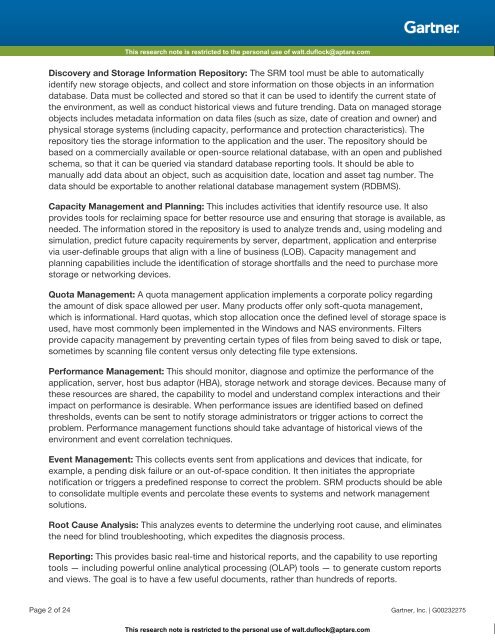Magic Quadrant for Storage Resource Management and SAN Management Software
Magic Quadrant for Storage Resource Management and ... - Aptare
Magic Quadrant for Storage Resource Management and ... - Aptare
You also want an ePaper? Increase the reach of your titles
YUMPU automatically turns print PDFs into web optimized ePapers that Google loves.
This research note is restricted to the personal use of walt.duflock@aptare.com<br />
Discovery <strong>and</strong> <strong>Storage</strong> In<strong>for</strong>mation Repository: The SRM tool must be able to automatically<br />
identify new storage objects, <strong>and</strong> collect <strong>and</strong> store in<strong>for</strong>mation on those objects in an in<strong>for</strong>mation<br />
database. Data must be collected <strong>and</strong> stored so that it can be used to identify the current state of<br />
the environment, as well as conduct historical views <strong>and</strong> future trending. Data on managed storage<br />
objects includes metadata in<strong>for</strong>mation on data files (such as size, date of creation <strong>and</strong> owner) <strong>and</strong><br />
physical storage systems (including capacity, per<strong>for</strong>mance <strong>and</strong> protection characteristics). The<br />
repository ties the storage in<strong>for</strong>mation to the application <strong>and</strong> the user. The repository should be<br />
based on a commercially available or open-source relational database, with an open <strong>and</strong> published<br />
schema, so that it can be queried via st<strong>and</strong>ard database reporting tools. It should be able to<br />
manually add data about an object, such as acquisition date, location <strong>and</strong> asset tag number. The<br />
data should be exportable to another relational database management system (RDBMS).<br />
Capacity <strong>Management</strong> <strong>and</strong> Planning: This includes activities that identify resource use. It also<br />
provides tools <strong>for</strong> reclaiming space <strong>for</strong> better resource use <strong>and</strong> ensuring that storage is available, as<br />
needed. The in<strong>for</strong>mation stored in the repository is used to analyze trends <strong>and</strong>, using modeling <strong>and</strong><br />
simulation, predict future capacity requirements by server, department, application <strong>and</strong> enterprise<br />
via user-definable groups that align with a line of business (LOB). Capacity management <strong>and</strong><br />
planning capabilities include the identification of storage shortfalls <strong>and</strong> the need to purchase more<br />
storage or networking devices.<br />
Quota <strong>Management</strong>: A quota management application implements a corporate policy regarding<br />
the amount of disk space allowed per user. Many products offer only soft-quota management,<br />
which is in<strong>for</strong>mational. Hard quotas, which stop allocation once the defined level of storage space is<br />
used, have most commonly been implemented in the Windows <strong>and</strong> NAS environments. Filters<br />
provide capacity management by preventing certain types of files from being saved to disk or tape,<br />
sometimes by scanning file content versus only detecting file type extensions.<br />
Per<strong>for</strong>mance <strong>Management</strong>: This should monitor, diagnose <strong>and</strong> optimize the per<strong>for</strong>mance of the<br />
application, server, host bus adaptor (HBA), storage network <strong>and</strong> storage devices. Because many of<br />
these resources are shared, the capability to model <strong>and</strong> underst<strong>and</strong> complex interactions <strong>and</strong> their<br />
impact on per<strong>for</strong>mance is desirable. When per<strong>for</strong>mance issues are identified based on defined<br />
thresholds, events can be sent to notify storage administrators or trigger actions to correct the<br />
problem. Per<strong>for</strong>mance management functions should take advantage of historical views of the<br />
environment <strong>and</strong> event correlation techniques.<br />
Event <strong>Management</strong>: This collects events sent from applications <strong>and</strong> devices that indicate, <strong>for</strong><br />
example, a pending disk failure or an out-of-space condition. It then initiates the appropriate<br />
notification or triggers a predefined response to correct the problem. SRM products should be able<br />
to consolidate multiple events <strong>and</strong> percolate these events to systems <strong>and</strong> network management<br />
solutions.<br />
Root Cause Analysis: This analyzes events to determine the underlying root cause, <strong>and</strong> eliminates<br />
the need <strong>for</strong> blind troubleshooting, which expedites the diagnosis process.<br />
Reporting: This provides basic real-time <strong>and</strong> historical reports, <strong>and</strong> the capability to use reporting<br />
tools — including powerful online analytical processing (OLAP) tools — to generate custom reports<br />
<strong>and</strong> views. The goal is to have a few useful documents, rather than hundreds of reports.<br />
Page 2 of 24<br />
Gartner, Inc. | G00232275<br />
This research note is restricted to the personal use of walt.duflock@aptare.com


